Please check back later for more on this topic.
Please check back later for more on this topic.
Please check back later for more on this topic.
Please check back later for more on this topic.
Please check back later for more on this topic.
Please check back later for more on this topic.
Chisolm’s Manual of Military Surgery
“In putting forth this Manual of Military Surgery for the use of Surgeons in the Confederate service, I have been led by the desire to mitigate, if possible, the horrors of war, as seen in its most frightful phase in military hospitals.”
Julian J. Chisolm
Preface to First Edition.
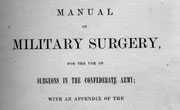
The first edition of J.J. Chisolm’s
A Manual of Military Surgery, 1861.
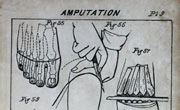
Amputation of the Foot,
A Manual of Military Surgery, 1863 edition.
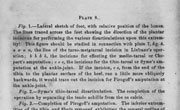
Instruction plate for the Amputation of the Foot,
A Manual of Military Surgery, 1864 edition.
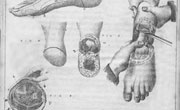
Amputation of the Foot,
A Manual of Military Surgery, 1864 edition.
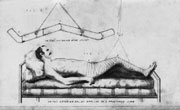
Smith’s Anterior Splint,
A Manual of Military Surgery, 1864 edition.
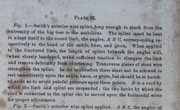
Instruction plate for Smith’s Anterior Splint,
A Manual of Military Surgery, 1864 edition.
“When the war suddenly broke upon us, followed immediately by the blockading of our
ports, all communication was cut off with Europe, which was the expected source of
our surgical information. As there had been no previous demand for works on military
surgery, there were none to be had in the country, and our physicians were compelled
to follow the army to the battle without instruction. No work on military surgery could
be purchased in the Confederate States. As military surgery, which is one of expediency,
differs so much from civil practice, the want of proper information has already made
itself seriously felt. In times of war, where invasion threatens, every citizen is expected
to do his duty to his state. I saw no better means of showing my willingness to enlist
in the cause than by preparing a manual of instruction for the use of the army, which
might be the means of saving the lives and preventing the mutilation of many friends
and countrymen.”
Julian J. Chisolm
Preface to First Edition.
From the outset of the war, Julian John Chisolm (1830-1903) realized that
knowledge of military medicine was practically non-existent among doctors in
the South. Using the knowledge gained during his time observing the treatment
of soldiers wounded in the Second Italian War of Independence (1859) in Milan,
Italy, Chisolm wrote and published his book, A Manual of Military Surgery: For
the Use of the Surgeons in the Confederate Army With an Appendix of the Rules
and Regulations of the Medical Department. First published in July 1861, the
manual described how to treat specific types of wounds, construct field hospitals,
and manage food, clothing, hygiene and non-surgical diseases. Later editions
contained detailed illustrations showing how to perform specific procedures such as
amputations. The manual became one of the most popular surgery books published
by the Confederates States of America and resulted in the publication of three
more editions. These later editions incorporated the knowledge gained from the
battlefield to improve the treatments of gunshot wounds.
Four editions of the manual were produced during the course of the war and are
now available for research use at the Waring Historical Library:
1861 edition
1862 edition
1864 edition
Or online:
1861 edition: http://www.archive.org/details/manualofmilitarychis
1862 edition: http://www.archive.org/details/manualofmilitar00chis
1863 edition: http://jdc.jefferson.edu/milsurgcsa/
1864 edition: http://www.archive.org/details/manualofmilita00chis
“After three years of incessant and bloody warfare I have been called upon to embody,
in a new edition of “The Manual of Military Surgery,” the large experience of the
medical staff of our army. It has been my aim to condense, in a concise, practical form,
the improvements in the treatment of gunshot wounds which have been developed
during our active campaigns, and repeatedly confirmed upon thousands of wounded.”
Preface to the Third Edition.